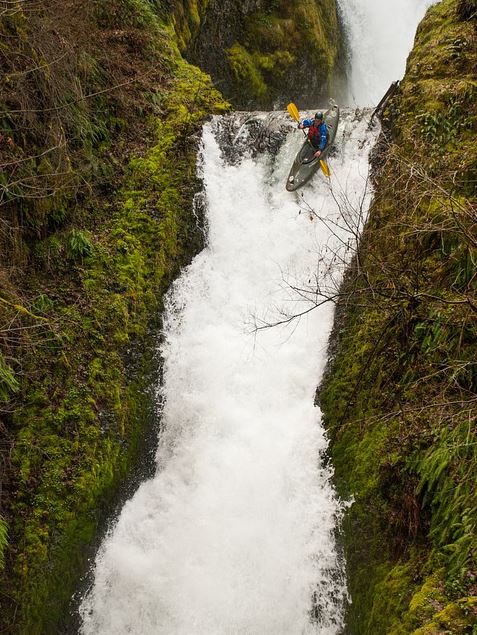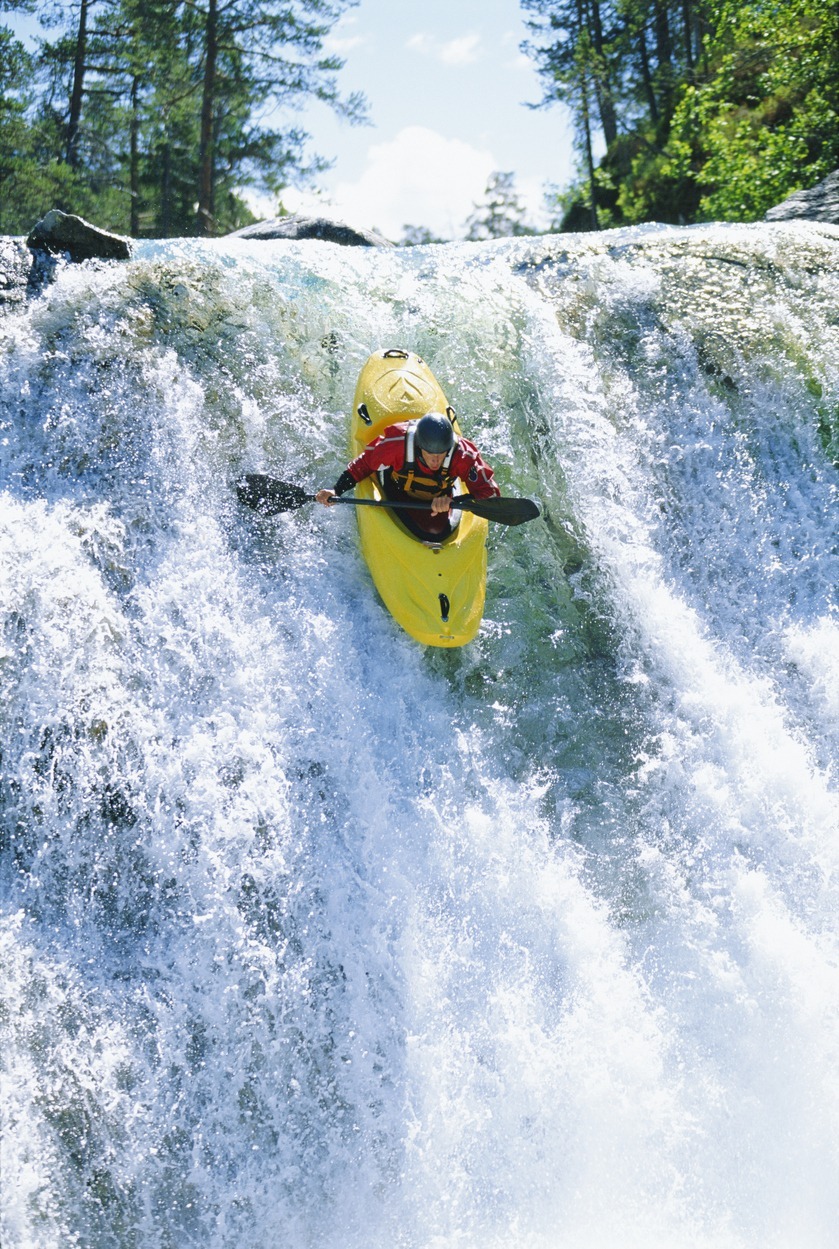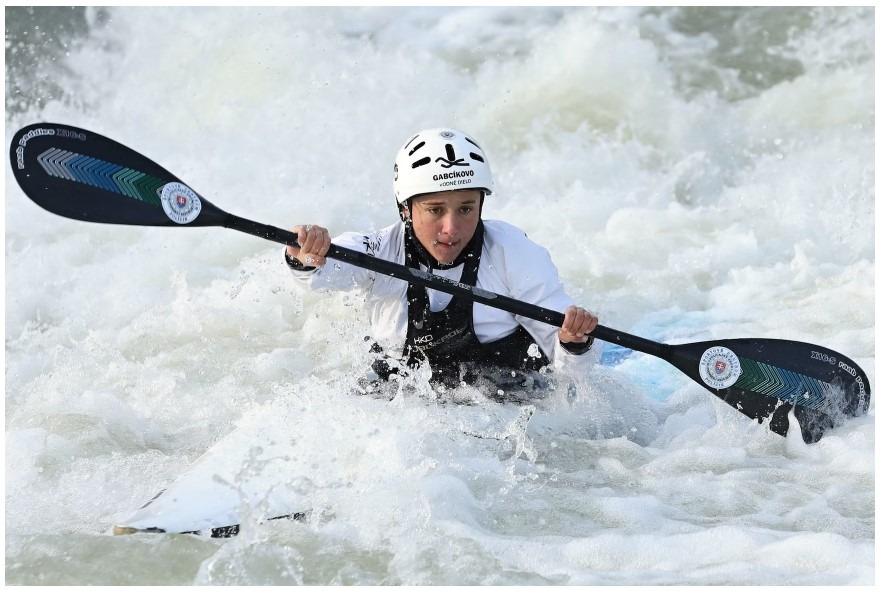Double-bladed paddle kayaking, also known as kanusport in some countries, is one of the world’s fastest-growing sports. Large mammals like walruses and whales were traditionally hunted in kayaks (from the Inuit word qayak). They were small enough to be highly maneuverable for chasing prey, with kayaks ranging in length from 3.6 meters up to 4.8 meters. Until recently, kayaks were primarily associated with men due to the fact that only men hunted in these societies.
A whitewater kayaking trip can be a relaxing, carefree float or a challenging, adrenaline-filled sport. Whitewater rapids are graded according to the International Scale of Difficulty.
Class I is the easiest (basically moving through flatwater) and class VI is the most difficult on a scale of river difficulty (which is rarely, if ever, run, and then only with a high risk of death). Large-volume rivers with rapids, running ledges, slides, and waterfalls are among the more common examples of the latter. A group of young paddlers who actively seek out the most dangerous and challenging rivers are at the heart of contemporary kayaking culture.
Essential Kayaking Equipment
- Kayak: Sea kayaks and touring kayaks are not at all like whitewater kayaks. Which kayak you choose depends on what kind of paddling you want to do and how good you are at it.
- Paddles: Different types of paddles are used for different kinds of kayaking. The store where you buy your gear can help you figure out which paddle goes with the kayak you buy.
- PFD stands for “Personal Flotation Device,” which is basically a kayaker’s life jacket or life preserver.
- Spray skirts keep water from getting into the kayak. For Whitewater and Sea Kayaking, you need them. Paddling a kayak for fun doesn’t need them. You must make sure that both you and the kayak fit in the skirt.
- Helmet: Whitewater kayaking requires you to wear a helmet. They aren’t needed to go Sea Kayaking. When Surf Kayaking, I always tell people to wear a helmet.
Non-essential Kayaking Equipment
- Dry Top, Drysuit, Wetsuit, or Paddle Jacket: This is completely up to your taste and the temperature of the water. Some people use a dry top all the time. Some people paddle all summer without any of these things.
- Booties: Make sure your booties are comfortable and that you can still get into your kayak while wearing them.
- Gloves: Some people don’t like to paddle with gloves on, but that’s a personal choice. Gloves not only keep your hands warm, but they also keep your knuckles from getting scraped or cut.
- Rope Bag: You could use it to save a friend’s life. I strongly suggest that every paddler bring a rope bag.
- Knife: This is probably something you’ll never use. If you get caught in a rope or get stuck under a raft, you’ll be glad you brought one.
- Float Bags: If you get separated from your boat, these bags that fit in the back of the kayak will keep it from sinking.
- Dry Bag: Your snacks and camera will stay dry in this. Just make sure it’s attached inside the boat.
How to Kayak Down a Big Waterfall
Whitewater kayaking is dangerous, especially in waterfalls. You assume many risks when you play, but there are many precautions you can take.
Wear a helmet and life jacket. Make sure everyone paddles with a throw rope.
Before running a waterfall or rapid, check for dangers and take precautions. When running a large waterfall, have a friend in a kayak below to rescue you if you swim or pass out. On shore, place a throw rope.
The ideal waterfall has volume, an aerated landing, and a gradual lip. Higher flows aerate the base of falls, cushioning your landing. Falls in “green water” (unaerated water) are painful!
Gradual drop-offs make navigating the falls easier. If a waterfall’s lip is sharp, it’s easy to over-rotate and land upside down. A gradual lip lets your boat transition from horizontal to vertical.
Look for waterfalls with high flows and gradual lips.
The right kayak will provide a smooth ride. You should paddle an 8-foot-long, round-hulled modern “creek boat.” A round hull is preferable to a flat ‘planing hull’ because it reduces landing impact.
Slowly approach the waterfall’s lip. Keep your boat aligned straight downstream with small strokes; don’t sprint towards the falls.
When your nose reaches the lip, your boat should be pointing straight or slightly off.
As your kayak approaches the waterfall, paddle vertically. If your boat was angled, your paddle should be on that side. Hold your blade in the water but don’t pull; the paddle should keep you stable and connected to the waterfall.
A big stroke at the lip could send you past the waterfall and to a flat landing. Flat landings are dangerous because they can break your back.
As you fall, keep your paddle perpendicular to the waterfall. You shouldn’t pull on the stroke, just stay in the current.
No matter how well you land a big waterfall, you’ll hit your backdeck. When your boat hits the water, it should be vertical. After impact, your boat will submerge and resurface upside down. If needed, roll!
When the waterfall is over 70 feet, paddles often break on impact. When you land over-vertical, your spray skirt may implode, forcing you to swim (i.e. partially on your head).
Kayakers must paddle away after landing a waterfall for official records.
5 Incredible Waterfalls to Paddle
Top kayakers have paddled some breathtaking waterfalls. Extreme kayakers are constantly discovering new waterfalls, but world-class classics keep paddlers coming back.
- Spirit Falls, White Salmon, WA, USA, 30ft/10m
This remote waterfall has bright blue water and epic wilderness surroundings, but it’s not the tallest. It’s a must-do for new kayakers.
- Uganda’s Murchison Falls (Right Channel) is 50-60ft/15-18m high.
Although the main section is un-runnable, a channel on the right creates a high volume rapid and waterfall that looks doable.
The risk is what comes after it, so whether anyone runs it is uncertain. The river flattens, attracting crocodiles and hippos. You’d need to get out of the water quickly, and leaving your boat won’t end well.
- Twisted Pleasure, Mexico, 60ft/18m
The challenge is not the waterfall itself, but the twisting rapid entrance and narrow spouting lip. It’s a world-class waterfall.
The entire run has too many drops and boofs to count. Twisted has an insane four-drop sequence. This section will be one of the scariest and best runs of your life.
- La Leona, Chile, 70ft/21m
This was not run for a long time because it has one of the narrowest entrance gorges in the world, which is nearly un-scoutable. Last year, Aniol Serrasolses, his brother, and another paddler opened it up for the rest of the world.
- Rainbow Falls, New Zealand, 90ft/27m
New Zealand is a popular kayaking destination, and this waterfall looks amazing when full. It has a wide lip, a big pool, and one of the best drop heights.
Conclusion
It takes years of experience paddling in whitewater before a kayaker can even begin to consider trying their hand at waterfall kayaking. It is possible that paddling a kayak through waterfalls is the pinnacle of the sport. There is nothing that can compare to the feeling of freefall that comes from stomping a clean line off a thirty-footer while maintaining control up to the lip, control while in the air, and a stylish landing.



